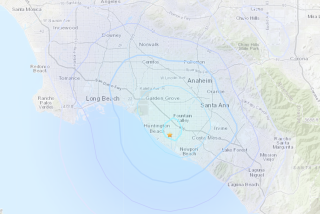The Battle of Huntington
- Share via
HUNTINGTON BEACH — Through the haze of cannon and rifle smoke, the Confederate Army advanced on the outnumbered Union Army. For the soldiers in blue, the battle had reached a pivotal moment. Would they hold their ground? Would they fight for God and country?
With Johnny Reb yards away, Luke Bjerke of the 100th Pennsylvania Volunteer Infantry looked inside himself and did what he had to do.
He turned tail and ran.
“The men just didn’t stand there and take it every time. Sometimes, they had to hastily reposition themselves,” said Bjerke, a history teacher from Lake Arrowhead and one of scores of uniformed soldiers staging a two-day Civil War reenactment at Central Park. “I didn’t really plan to run away today. I just like to do it every now and then to add realism.”
The mock Civil War battle and accompanying military encampments, weaponry demonstrations and other period exhibits attracted thousands of spectators Saturday.
“This is great,” said Fountain Valley resident Mark Matthews, joined by his 6-year-old son Tanner. “We can check out books and rent movies about the Civil War, but it’s just not the same as seeing it.”
The reenactment continues today with a battlefield church service at 8 a.m., and mock battles at 11 a.m. and 2 p.m. The event, co-sponsored by the Huntington Beach Historical Society and the city of Huntington Beach, is free.
*
Overall, the 30-minute skirmishes drew rave reviews from the throngs who encircled the battleground. Spectators cheered the soldiers--dressed in replicas of the wool uniforms of the day--as they marched onto the battlefield and began exchanging volley after volley of gunfire.
The audience, however, took to covering its ears when both sides began blasting their artillery.
“I didn’t realize the guns back then made this much noise,” said Huntington Beach resident Chris Macha, 44, who brought his three kids to watch the first battle between the Blue and the Gray. “The real battles must have been really loud.”
But to some, the battle lacked a crucial bit of reality.
“There wasn’t enough people dying,” noted Greg Steele, a 19-year-old Marine stationed at El Toro. “But I know they didn’t really have enough people for that.”
When the guns from the mock battle fell silent, many visitors swapped Civil War tales with reenactment soldiers as they prepared food over campfire or cleaned their weapons.
Those with strong stomachs ventured over to Dr. Erasmus “Dirty Shirt” Rose’s tent, where the regimental surgeon vividly described the grim medical techniques of the day. Many wounded soldiers routinely underwent amputation, and to hammer home the point, Rose displayed a bathtub half-full of hacked off limbs.
“It was pretty messy,” said Rose, 50, a clinical psychologist from Whittier whose real name is Roger Rose.
Though wounds could often be fatal, Rose pointed out that far more soldiers died of disease than battle. Of the 623,000 dead in the Civil War, about 400,000 perished from diseases like typhus.
True to the time, the reenactment came with its own entertainment for the soldiers. Apparently, bands of women, some of them prostitutes, shadowed armies from both sides, often running gambling tables or other games of chance.
“The women who fell into this usually had no family or were very, very poor,” said Johanna Vignol, 30, a San Diego drama teacher wearing a wool hoop skirt and bonnet. “There is a misconception that prostitutes walked around in their underwear. It’s not true. You couldn’t tell the ladies from those in the gambling establishment.”
Though he shied away from the gambling tables, Abraham Lincoln (a.k.a. William T. Peck, a member of the Assn. of Lincoln Presenters) roamed the park telling tales about his early days and political career.
“I really enjoy talking to the young people about the president,” said Peck, with a Lincoln beard and stovepipe hat. “I try to tell stories about his life that contain a moral.”
The reenactments even won recruits. After talking to soldiers in the Confederate camp, Patrick Hubble, a high school history teacher from Costa Mesa, shed his T-shirt and shorts for the gray wool uniform and black leather boots of a Virginia volunteer.
“This whole period is just fascinating,” said Hubble, 43, who had relatives fight on both sides of the Civil War. “I’ve always wondered what made men keep going into battle when they knew they were going to die. It blows me away.”
More to Read
Sign up for Essential California
The most important California stories and recommendations in your inbox every morning.
You may occasionally receive promotional content from the Los Angeles Times.













